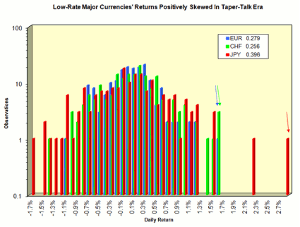Taper talk in the US has created a skewness pattern in low-rate currencies, notes Howard Simons on Minyanville.com, which has made the job of weakening their currencies that much more difficult for Japan and Switzerland.
At first blush the Japanese yen appears to have little in common with Dracula and Rasputin, until you consider how much effort was expended to dispatch the latter two, and how much the Abe government and the Bank of Japan have done to weaken the yen since November 2012 with only grudging success so far.
I mentioned on Monday only six of 28 currencies examined have had lower average daily interest rate returns than the US dollar since taper talk began in May 2013. Three of those currencies are the Japanese yen, Swiss franc, and the euro; all three are members of the ICE dollar index, accessible in ETF form by such vehicles as the Power Shares US Dollar Bullish Fund (UUP) and the Power Shares US Dollar Bearish Fund (UDN).
Both the yen and the franc, like the dollar, have been funding currencies for global currency trades for years. The euro would have joined the party had the creators of the European Monetary Union had the foresight to short-circuit Germany's concerns about wanton monetary creation and provided a mechanism for European QE. Even so, successes to date in avoiding deflation in the US, UK, Switzerland, and Japan have emboldened the ECB to push the envelope on monetary creation. This has been done in the name of forestalling deflation, central bankers' favorite monster under the bed.
One Side of the Boat
One of the problems with carry trades, including those within domestic yield curves involving borrowing short to lend long, is they tend to become crowded. People who fancy themselves having both oars in the water wind up on the same side of the boat, a chilling concept where Carnival Cruise Lines (CCL) might be involved. This means those who have borrowed the funding currencies and lent in the higher-yielding receiving currencies almost always encounter execution vacuums when they find they are for whom the bell tolled.
Skews You Can Use
How has this translated into daily currency returns since May 2013? The answer has been in a positively skewed way; a histogram of the three currencies' returns shows how their distributions are shifted off to the right-hand side of the chart. I included their coefficients of skewness in the legend and marked with arrows last Thursday's data points.
This skewness pattern has been one reason why both Japan and Switzerland have had such difficulty in driving the yen and franc lower. In both cases, a heavily borrowed currency is prone to bursts of short covering for reasons ranging from Japan's periodic liquidity shocks produced by natural disasters to Switzerland's role as a safe haven from periodic Eurozone financial crises. Traders who have been scalded by these execution vacuums tire of the process eventually and reduce their exposure to those currencies.
Because the Treasury and Federal Reserve have established complete credibility with markets, they can ruin the greenback's purchasing power with few intervening hiccups, which is one of the reasons the dollar has been able to sustain very long-running downtrends over the past 40 years. Whether this “Shiva, destroyer of worlds” prowess is something anyone should want to put on their LinkedIn (LNKD) resume is another matter altogether.
Howard Simons, Contributor, Minyanville.com





















